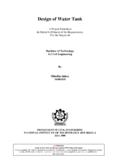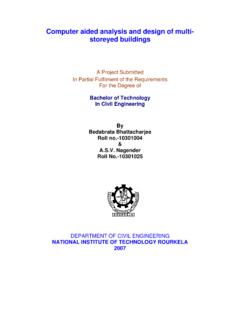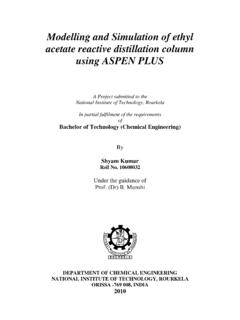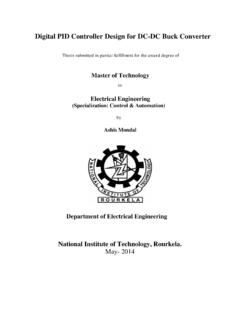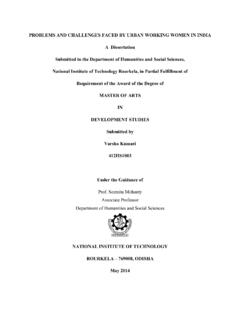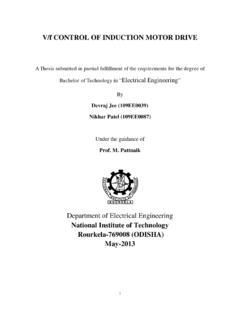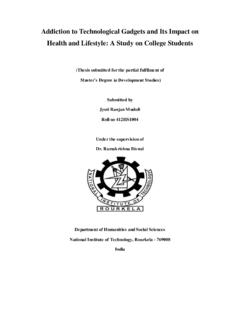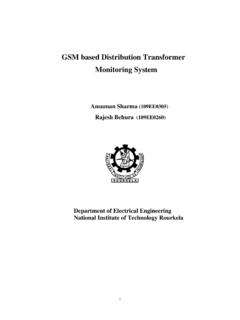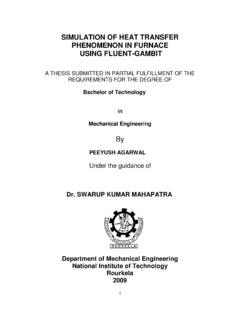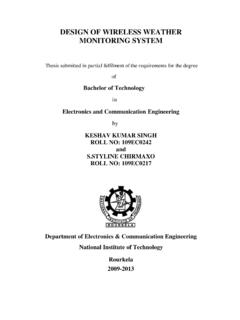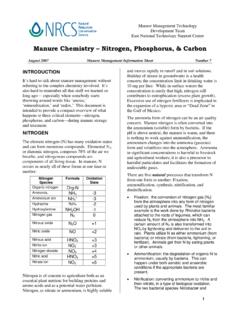Transcription of MANUFACTURE OF UREA
1 MANUFACTURE OF urea . A THESIS SUBMITTED IN PARTIAL FULFILLMENT. OF THE REQUIREMENTS FOR THE DEGREE OF. Bachelor of technology in Chemical Engineering By KUMAR BHASKAR & PRATAP CHANDRA DAS. Department of Chemical Engineering National Institute of Technology Rourkela 2007. MANUFACTURE OF urea . A THESIS SUBMITTED IN PARTIAL FULFILLMENT. OF THE REQUIREMENTS FOR THE DEGREE OF. Bachelor of technology in Chemical Engineering By KUMAR BHASKAR & PRATAP CHANDRA DAS. Under the Guidance of Prof. S K Agarwal Department of Chemical Engineering National Institute of Technology Rourkela 2007. National Institute of Technology Rourkela CERTIFICATE. This is to certify that the thesis entitled, MANUFACTURE OF urea submitted by Sri KUMAR BHASKAR & PRATAP CHANDRA DAS in partial fulfillments for the requirements for the award of Bachelor of Technology Degree in Chemical Engineering at National Institute of Technology, Rourkela (Deemed University) is an authentic work carried out by them under my supervision and guidance.
2 To the best of my knowledge, the matter embodied in the thesis has not been submitted to any other University / Institute for the award of any Degree or Diploma. Date: Prof S K AGARWAL. Department of Chemical Engg. NIT,Rourkela ACKNOWLEDGEMENT. We wish to express our deep sense of gratitude and indebtedness to Prof. S K. Agarwal, Department of Chemical Engineering, Rourkela for introducing the present topic and for his inspiring guidance, constructive criticism and valuable suggestion throughout this project work. We would like to express our gratitude to Prof P Rath (Head of the Department). & Prof R K Singh for his constant support and encouragement. We are also thankful to all staff members of Department of Chemical Engineering NIT Rourkela. 3rd May 2007 Kumar Bhaskar Roll: 10300029. Pratap Chandra Das Roll: 10300028. CONTENTS. CHAPTER TITLE PAGE No. Abstract 1 Introduction MANUFACTURE of urea 1.
3 Properties of urea 2. Uses of urea 2. Process technology 3. Process in general 3. Major engineering problems 7. 2 Various methods of MANUFACTURE of urea Various processes for the MANUFACTURE of urea 9. Selection of the process 17. 3 Selected process :Snamprogetti ammonia stripping process Manufacturing process 21. Effect of various parameters 22. Snamprogetti stripping process 23. Process description 24. 4 Material balance Around reactor 33. Around stripper 34. Around medium pressure separator 35. Around low pressure separator 36. Around Vacuum evaporator 37. Around Prilling tower 38. 5 Energy balance Around reactor 41. Around stripper 43. Around carbamate condenser 45. Around medium pressure separator 46. Around low pressure separator 48. Around vacuum evaporator 50. Around prilling tower 52. 6 Equipment design Reactor design 55. Thickness of shell 59. Head design 60. Diameter of pipes 61.
4 Skirt support for reactor 62. Evaporator design 64. Design 68. Wall thickness calculation 68. Separator 71. Bottom head design 72. Result & discussion 75. References 76. ABSTRACT. urea is in many ways the most convenient form for fixed nitrogen. It has the highest nitrogen content available in a solid fertilizer (46 %).It is easy to produce as prills or granules and easily transported in bulk or bags with no explosive hazard. It leaves no salt residue after use on crops. Its specific gravity is , decomposes on boiling and is fairly soluble in water. The principal raw materials required for this purpose are NH3 & reactions are involved in the MANUFACTURE of urea . First, ammonium carbamate is formed under pressure by reaction between CO2 & NH3. CO2 + 2NH3 NH2 COONH4 H= Kcal This highly exothermic reaction is followed by an endothermic decomposition of the ammonium carbamate. NH2 COONH4 NH2 CONH2 + H2O H= + Kcal Various processes for the MANUFACTURE of urea are: 1) Snamprogetti ammonia stripping process 2) Stamicarbon CO2 stripping process 3) Once through urea process 4) Mitsui Toatsu total recycle urea process We selected the Snamprogetti ammonia stripping process for the MANUFACTURE of urea .
5 In this process ammonia & CO2 are compressed & fed to the reactor. The unconverted carbamate is stripped and recovered from the urea synthesis reactor effluent solution at reactor pressure, condensed to an aqueous solution in a steam producing high pressure condenser & recycled back to the reactor by gravity. Part of the liquid NH3 reactor feed, vapourized in a steam heated exchanger, is used as inert gas to decompose & strip ammonium carbamate in the steam heated high pressure stripper. Energy balance & material balance of the plant is done. The selected capacity of the plant is 4,50,000 tons/year of urea producing 62,500 kg/hr of urea with 98 % purity. urea reactor & vacuum evaporator are designed. The volume of reactor is calculated & found to be 195 m3. The length & diameter of the reactor are 40 m & m respectively. The evaporator used is of climbing-film long- tube type. Snamprogetti ammonia-stripping urea process is selected because it involves a high NH3.
6 To CO2 ratio in the reactor, ensuring the high conversion of carbamate to urea . The highly efficient ammonia stripping operation drastically reduces the recycling of carbamate and the size of equipment in the carbamate decomposition . Snamprogetti technology differs from competitors in being based on the use of excess ammonia to avoid corrosion as well as promote the decomposition of unconverted carbamate into urea . Uses of urea : About 56 % of urea manufactured is used in solid fertilizer. About 31 % of urea manufactured is used in liquid fertilizer. urea -formaldehyde resins have large use as a plywood adhesive. Melamine-formaldehyde resins are used as dinnerware & for making extra hard surfaces. Chapter 1. INTRODUCTION. MANUFACTURE OF urea [1]. urea is an important nitrogenous fertilizer. Its utilization is increasing steadily, it being the preferred nitrogen fertilizer worldwide.
7 It is used in solid fertilizer, liquid fertilizer, formaldehyde resins and adhesives. Rouelle first discovered urea in urine in 1773. His discovery was followed by the synthesis of urea from ammonia and cyanic acid by Woehler in 1828. This is considered to be the first synthesis of an organic compound from an inorganic compound. In 1870, Bassarow produced urea by heating ammonium carbamate in a sealed tube in what was the first synthesis of urea by chemical formula of, NH2 CONH2, indicates that urea can be considered to be the amide of carbamic acid NH2 COOH, or the diamide of carbonic acid CO(OH)2. Fertilizer is generally defined as any material, organic or inorganic, natural or synthetic, which supplies one or more of the chemical elements required for the plant growth . The main aim of the fertilizer industry is to provide the primary and secondary nutrients which are required in macro quantities.
8 Primary nutrients are normally supplied through chemical fertilizers . They are chemical compounds containing one or more of the primary nutrients and are generally produced by chemical reactions. Whatever may be the chemical compounds, its most important ingredient for plant growth is the nutrient content . The primary nutrients are Nitrogen, Phosphorus and Potassium. However, their concentration in a chemical fertilizer is expressed as a percentage of total nitrogen (N), available phosphate (P2O5) and soluble K2O. The grade of a fertilizer is expressed as a set of three numbers in the order of percent N, P2O5 and K2O. If a nutrient is missing in a fertilizer, it is represented by a zero. Thus ammonium sulphate is represented by 0. PROPERTIES OF urea : PHYSICAL PROPERTIES OF urea . urea is a white, odorless, hygroscopic solid. It is non-corrosive. CHEMICAL PROPERTIES OF urea . Molecular weight Relative humidity 60 %.
9 Maximum Nitrogen content %. Specific gravity Heat of fusion 60 Cal/gm (endothermic). Heat of solution, in water 58 Cal/gm (endothermic). Bulk density gm/cc SPECIFIC HEAT OF urea . Temperature, oC Specific heat, Kj/kg oC. 0 50 100 150 USES OF urea . About 56 % of urea manufactured is used in solid fertilizer. About 31 % of urea manufactured is used in liquid fertilizer. urea -formaldehyde resins have large use as a plywood adhesive. Melamine-formaldehyde resins are used as dinnerware & for making extra hard surfaces. PROCESS TECHNOLOGY. Although there are several processes currently used for the MANUFACTURE of urea , the underlying principle for all the processes is same. The two main reactions involved are: 1) CO2 + 2NH3 NH2 COONH4 H= Kcal/gm mol 2) NH2 COONH4 NH2 CONH2 + H2O H= + Kcal/gm mol Undesirable side reaction taking place is: 3) 2NH2 CONH2 NH2 CONHCONH2 + NH3. (Biuret). Both 1st & 2nd reactions are equilibrium reactions.
10 The 1st reaction almost goes to completion at 185-190 oC & 180-200 atms. The 2nd reaction (decomposition reaction) is slow and determines the rate of the reaction. Unconverted CO2 & NH3, along with undecomposed carbamate, must be recovered and re-used. This is a troublesome step. The synthesis is further complicated by the formation of a dimer called biuret, NH2 CONHCONH2, which must be kept low because it adversely affects the growth of some plants. PROCESS IN GENERAL. [2]. Ammonia & CO2 are compressed separately and fed to the high pressure (180 atms). autoclave as shown in which must be water cooled due to the highly exothermic nature of the reaction. A mixture of urea , ammonium carbamate, H2O and unreacted (. NH3+CO2) is produced. This liquid effluent is let down to 27 atms and fed to a special flash-evaporator containing a gas-liquid separator and condenser. Unreacted NH3, CO2 & H2O are thus removed & recycled.
